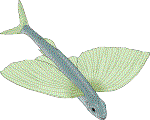Flight
Behavior III: Flight Path in the Horizontal Plane

Characteristics of Straight, Circling,
Variable and Erratic Flight Paths
Once again, classifying the flight path of the butterfly into one of three categories, straight, circling, and erratic, is easy - as long as its straight. A flight path is classified as Straight when the butterfly continues to fly on the same bearing and shows no conspicuous rotation of its body, either to the left, or to the right. Straight flapping flight, or straight flapping flight alternating with straight gliding flight, are the normal flight modes for monarch butterflies migrating within 3 m of the ground. Straight gliding flight and straight soaring flight are common when the butterflies are higher than 100 m above the ground. Other migratory species have their own patterns.
Circling flight is associated with soaring. The common impression that soaring flight is always characterised by of slowly flying in circles while drifting upward is very misleading. It's true that this pattern is seen, particularly among soaring monarch butterflies. But thermals are frequently too turbulent and/or poorly organised for this tactic. As a result, the butterflies must drawn on a much greater range of behaviours than slow, circling flight to effectively exploit the kinetic energy of thermals. A smooth series of 360° turns while spiralling effortlessly upward toward cloudbase is a rare event. Usually butterflies, and glider pilots, have to manoeuvre continuously to remain within the center of the rising air. The butterflies can be seen abruptly changing the direction of their turn, changing the diameter of their circle, and moving towards other circling butterflies. All of these manoeuvres serve to keep the butterflies within the thermal while allowing them to explore for area of stronger lift. Glider pilots do pretty much the same thing, the main difference being that we are not supposed to change the direction of our turn when other gliders are in the same thermal. For convenience of recording data, all manoeuvres consisting of turns that serve to keep a butterflies within thermals, or other sources of lift, including manoeuvres consisting of turns interspersed with short periods of straight flight, will be classified as circling flight. basically, circling butterflies are just milling about in a thermal and doing whatever is necessary to keep from being bounced out by the turbulence.
Variable flight consists of steady, alternating, changes in flight direction. The changes are usually less than about 45° and appear to be a search for rising air. Migrating monarch butterflies engaged in variable flight are usually flying higher than about 10 meters above the ground. They steadily shift their heading from side to side to produce a winding flight path. The butterflies often abruptly switch to circling, soaring, flight, or alternate between the two flight modes. I suspect that Monarch butterflies use variable flight to explore regions rising air in which the lift is too weak to support soaring flight. Presumably, the butterflies switch to circling flight when they succeed in locating a patch where the lift is stronger. I'm suggest this interpretation because this is the tactic I use when flying the Grob glider C-FUSD through the large areas of weak lift that rise from wood lots in the late afternoon.
Tip: Butterflies that are engaged in variable flight within a few meters of the ground are probably foraging instead of migrating, particularly if they land. Remember, any low flying butterflies that investigate flowers, possible host plants, open patches of ground, etc., should be considered foragers.
Erratic flight is used for predator avoidance and consists of a series of abrupt side-to-side and up-and-down changes in direction, often combined with violent aerobatic manoeuvres such as barrel rolls, spiral dives, or loops. Monarch butterflies usually engage in erratic flight when they are flying well above the ground and are approached too closely by a bird. Monarch butterflies, and other butterflies, will also give a classical demonstration of erratic flight if you swing a net at them and miss. Other migratory species, such as buckeyes, frequently break into brief periods of erratic side-to-side, and up-and-down erratic flight without any apparent reason. The behaviour may serve both to discourage attack by birds (protean defence) and to keep their wing muscles warm enough to deliver full power for predator avoidance manoeuvres. Other species, such as cloudless sulphurs, apparently seem to migrate in the erratic flight mode. Large species of migratory dragonflies also switch form soaring flight to erratic flight. Although the dragonflies are often manoeuvring to capture prey, they may also be heating their wing muscles and engaging in a protean defence. Butterflies flying in a strong wind and encountering significant turbulence can be thrown several meters up and down (and from side to side), despite apparent attempts to hold to a particular flight level. In this situation, classifying the flight path can be very difficult. If the butterflies appear to be bounced around by turbulence, then just record the average flight level and ignore the apparent erratic flight. On the other hand, if the butterflies appear to be amplifying the situation, then record it as erratic flight. Watching two species migrating past at the same time that have very different frequencies of erratic flight (e.g. monarch butterflies and Gulf fritillaries) can help in judging whether the apparent erratic flight is 'deliberate' or the result of turbulence.